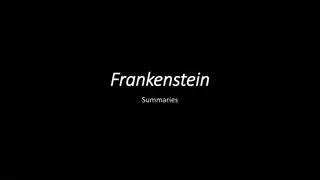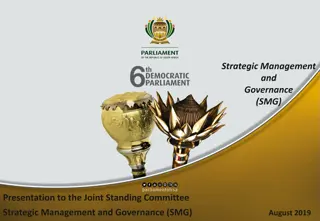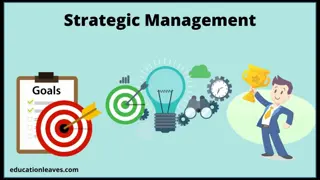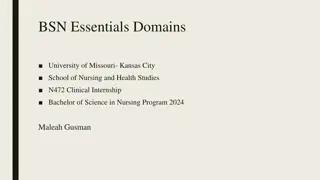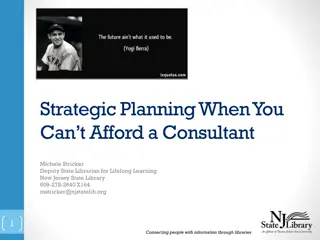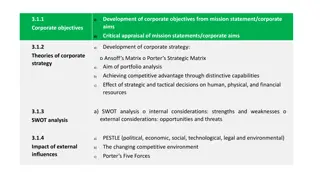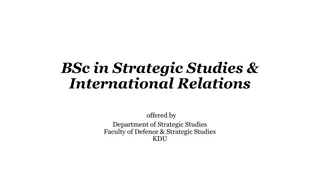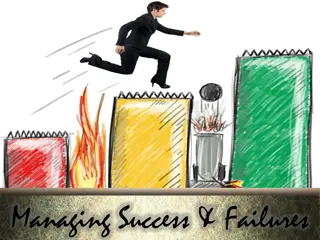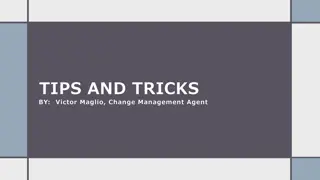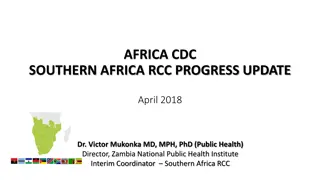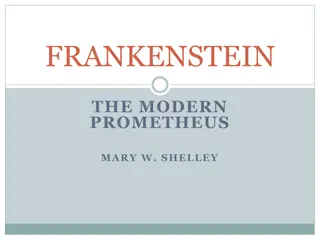Strategic Management Essentials with Mr. Mulusa Victor
Explore the fundamentals of strategic management with Mr. Mulusa Victor, covering key aspects such as business mission, strategic objectives, and formulating strategy. Understand the importance and definitions of strategy and delve into the responsibilities involved.
Download Presentation

Please find below an Image/Link to download the presentation.
The content on the website is provided AS IS for your information and personal use only. It may not be sold, licensed, or shared on other websites without obtaining consent from the author. Download presentation by click this link. If you encounter any issues during the download, it is possible that the publisher has removed the file from their server.
E N D
Presentation Transcript
Strategic Management Mr. Mulusa Victor PhD Candidate, MBA, BBA (CBU), PDTM,MZIM vmulusa@unilus.ac.zm
Summary of lecture Introduction Whose responsibility is it Why it matters Definitions Business mission Strategic Objectives What is Strategy? Formulating Strategy Primary Determinants of Strategy
Introduction Investors stake there money into a firm in order to earn a return on their investments. Returns are often measured in terms of accounting figures i.e. return on assets, return on equity, or return on sales. In smaller, new venture firms, returns are sometimes measured in terms of the amount and speed of growth. Firms without a competitive advantage earn, at best, average returns.
Whose responsibility is it? And why it matters The investors give the responsibility to the directors and subsequently managers (CEO) of a firm to earn a return on their investment. Inability to earn at least average returns results first in decline and, eventually, failure. Failure occurs because investors withdraw their investments from those firms earning less-than-average returns. Firms with a competitive advantage will aim to earn Above Average Returns.
What is strategic management? Most firms use the strategic management process as the foundation for the commitments, decisions, and actions they will take when pursuing Strategic Competitiveness and Above-Average Returns. Strategic competitiveness is achieved when a firm successfully formulates and implements a value- creating Strategy. A Strategy is an integrated and coordinated set of commitments and actions designed to gain a Competitive Advantage. When choosing a strategy, firms make choices among competing alternatives as the pathway for deciding how they will pursue Strategic Competitiveness. The chosen strategy indicates what the firm will do as well as what the firm will not do.
STRATEGIC MANAGEMENT DEFINED Strategic management is that set of managerial decisions and actions that determines the long- run performance of a corporation. The study of strategic management, therefore, emphasizes the monitoring and evaluating of external opportunities and threats in light of a corporation s strengths and weaknesses. Strategic management, as a field of study, incorporates the integrative concerns of business policy with a heavier environmental and strategic emphasis.
STRATEGIC MANAGEMENT DEFINED Cont d The term strategic management underlines the importance of managers with regard to strategy to formulate them as strategies do not happen just by themselves. Strategy involves people especially managers who decide and implement strategy. Therefore, Strategic Management includes understanding the Strategic Position of an organization, Strategic Choices for the future and managing Strategy in Action. Strategy is the direction and scope of an organization over the long-term, which achieves advantage in a changing environment through its configuration of resources and competences with the aim of fulfilling stakeholder expectations. (Scholes- Exploring Corporate Strategy)
Strategic management process The Strategic Management Process is the full set of commitments, decisions, and actions required for a firm to achieve strategic competitiveness and earn above-average returns. The firm s first step in the process is to analyze its External Environment and Internal Organization to determine its resources, capabilities, and core competencies - the sources of its strategic inputs. With this information, the firm develops its Vision and Mission and formulates one or more strategies.
Strategic Management process The External Environment Vision Mission Inputs The Internal Organization Strategy Formulation Competitive Rivalry and Competitive Dynamics International Strategy Strategy Implementation Corporate Governance Strategic Leadership Corporate- Level Strategy Cooperative Strategy Organizational Structure and Controls Strategic Entrepreneurship Business-Level Strategy Actions Merger and Acquisition Strategies Strategic Competitiveness Above Average Returns Outcomes Feedback
vision A vision or strategic intent is the desired future state of the organization. It is an aspiration around which a strategist, perhaps CEO, might seek to focus the attention and energies of members of the organization. A vision is a picture of what the firm wants to be and, in broad terms, what it wants to ultimately achieve. A vision statement tends to be relatively short and concise, making it easily remembered. Examples of vision statements include the following: To be the leading supplier of mining equipment in Zambia. To be a world class provider of tuition to under graduate and post graduate students.
Mission A mission is a general expression of the overall purpose of the organization, which is in line with the values and expectations of major stake-holders. It answers the challenging question: What Business Are We In? A mission should establish a firm s individuality and should be inspiring and relevant to all stakeholders. Together, vision and mission provide the foundation the firm needs to choose and implement one or more strategies. Even though the final responsibility for forming the firm s mission rests with the CEO, the CEO and other top-level managers tend to involve a larger number of people in forming the mission. Example of mission statement: To provide cost effective mining solutions, products, and services that exceed the expectations of our customers.
Strategy terms Term Definition A personal example Mission Overriding purpose in line with the values or expectations of stakeholders Be healthy and fit Vision or Strategic intent Desired future state: the aspiration of the organization General statement of aim or purpose To run the London Marathon Goal Objective Lose weight and strengthen muscles Quantification (if possible) or more precise statement of the goal Lose 5 kilos by 1 September and run marathon next year Strategic capability Resources, activities and processes. Some will be unique and provide competitive advantage Long-term direction Proximity to a fitness centre, a successful diet Strategies Exercise regularly, compete in marathons locally, stick to appropriate diet Business model How product, service and information flow between participating parties Associate with a collaborative network (e.g. join a running club) Control The monitoring of action steps to: Assess effectiveness of strategies and actions. Modify as necessary strategies Monitor weight, run and measure times: if possible satisfactory, do nothing; if not, consider other strategies and actions
The Benefits of Strategic Management Research has revealed that organizations that engage in strategic management generally outperform those that do not. A survey of nearly 50 corporations in a variety of countries and industries found the 3 most highly rated benefits of strategic management to be: Clearer sense of strategic vision for the firm Sharper focus on what is strategically important Improved understanding of a rapidly changing environment
Three questions which characterize strategic management To be effective, however, strategic management need not always be a formal process. It can begin with three (3) basic questions: 1. Where is the organization now? (Not where do we hope it is!) 2. If no changes are made, where will the organization be in 1 year? 2 years? 5 years? 10 years? Are the answers acceptable? 3. If the answers are not acceptable, what specific actions should management undertake? What are the risks and benefits involved?
MAJOR ELEMENTS OF STRATEGIC MANAGEMENT Strategic management includes the following elements: Environmental scanning (both external and internal) Strategy formulation (strategic or long-range planning) Strategy implementation Evaluation and control
ANALYZING A CASE STUDY The purpose of the case study is to let the student apply the concepts of strategic management to a real or hypothesized situation facing a specific company. To analyse a case study, therefore, you must examine closely the issues with which the company is confronted. Most often you will need to read the case several times once to grasp the overall picture of what is happening to the company and then several times more to discover and grasp the specific problems.
Eight (8) steps in Conducting a detailed case study analysis 1. The history, development, and growth of the company over time. 2. The identification of the company s internal strengths and weaknesses. 3. The nature of the external environment surrounding the company. 4. A SWOT analysis.
case study analysis Contd 5. The kind of corporate-level strategy pursued by the company. 6. The nature of the company s business-level strategy. 7. The company s structure and control systems and how they match its strategy. 8. Recommendations.
ENVIRONMENTAL SCANNING This is the monitoring, evaluating and disseminating of information from the external and internal environments to key people within the corporation. Its purpose is to identify strategic factors those external and internal elements that will determine the future of the corporation. The simplest way to conduct environmental scanning is through SWOT analysis. SWOT is an acronym used to describe those particular Strengths, Weaknesses, Opportunities and Threats that are strategic factors for a specific company.
The external environment This environment consists of variables (Opportunities and Threats) that are outside the organization. These variables form the context within which the organization exists. The key environmental variables may be: general forces and trends within the overall societal environment (economic, technological, political-legal, socio-cultural forces) or specific factors that operate within an organization s task environment often called its industry (shareholders, suppliers, employees/labour unions, competitors, trade associations, communities, creditors, customers, special interest groups, governments).
The internal environment The internal environment of a corporation consists of variables (Strengths and Weaknesses) that are within the organization itself and are usually within the short-run control of top management. These variables form the context in which work is done. They include the corporation s structure, culture and resources. Key strengths form a set of core competencies that the corporation can use to gain competitive advantage.
STRATEGY FORMULATION This is the development of long-range plans for the effective management of environmental opportunities and threats, in light of corporate strengths and weaknesses. It includes defining the corporate mission, specifying achievable objectives, developing strategies, and setting policy guidelines
Mission An organization s mission is the purpose or reason for the organization s existence. It tells what the company is providing to society, either a service or a product. A well-conceived mission statement: defines the fundamental, unique purpose that sets a company apart from other firms of its type and identifies the scope of the company s operations in terms of products and services offered and markets served.
Objectives These are the end results of planned activity. They state what is to be accomplished by when and should be quantified if possible. The achievement of corporate objectives should result in the fulfilment of a corporation s mission. In effect, this is what society gives back to the corporation when the corporation does a good job of fulfilling its mission.
Objectives Contd Some of the areas in which a corporation might establish its goals and objectives are: Profitability (e.g. net profits) Efficiency (e.g. low costs, etc.) Growth (e.g. increase in total assets, sales, etc.) Shareholder wealth (dividends plus stock price appreciation) Utilization of resources ( e.g. return on investment or equity) Reputation (being considered a top firm) Contributions to employees (employment security, wages, diversity) Contributions to society (taxes paid, participation in charities etc)
Strategies A strategy of a corporation forms a comprehensive master plan stating how the corporation will achieve its objectives and fulfil its mission. It maximizes competitive advantage and minimizes competitive disadvantage. The typical business firm usually considers 3 types of strategy: Corporate, Business and Functional.
1. Corporate Strategy This describes a company s overall direction in terms of its general attitude toward growth and the management of its various businesses and product lines. Corporate strategies typically fit within the 3 main categories of stability, growth and retrenchment.
Corporate-Level Strategy. Corporate-level strategy is senior management's game plan for directing and running the organization as a whole. It cuts across all of an' organization's activities-its different businesses, divisions, product lines, and technologies. The task of developing a corporate strategy has three elements:
ELEMENT 1: Managing The Scope & Mix of The Firm s Activities Developing plans for managing the scope and mix of the firms' various activities in order to improve corporate performance. Managing the business portfolio requires decisions' and actions regarding when and how the enterprise should get into new businesses. which existing businesses the company should get out of (and whether it should do so quickly or gradually), The portfolio management plan may, in addition, involve designating a common strategic theme to be pursued by all of the company's lines of business.
Providing for coordination among different businesses in the portfolio. Coordination of interrelated activities allows a diversified firm to; enhance the competitive strength of its business units and makes overall corporate strategy more than just a collection of the action plans of independent subunits.
Establishing Investment Priorities & Allocating Corporate Resources Across The Company's Different SBUs. Decisions about how much of the corporate investment budget each organizational unit will get and actions to control the pattern of corporate resource allocation. These decisions and actions serve to channel resources out of areas where earnings potentials are lower into areas where they are higher. The portfolio management actions of corporate officers in entering or exiting certain markets.
2. Business Strategy This usually occurs at the business unit or product level, and it emphasizes improvement of the competitive position of a corporation s products or services in the specific industry or market segment served by that business unit. Business strategies may fit within the 2 overall categories of competitive or cooperative strategies. Competitive strategies include differentiation, cost leadership and focus.
3. Functional Strategy This is the approach taken by a functional area to achieve corporate and business unit objectives and strategies by maximizing resource productivity. It is concerned with developing and nurturing a distinctive competence to provide a company or business unit with a competitive advantage. Examples of R&D functional strategies are Technological followership (imitate the products of other companies) and Technological leadership (pioneer an innovation). Business firms use all 3 types of strategy simultaneously.
HIERARCHY OF STRATEGY A hierarchy of strategy is the grouping of strategy types by level in the organization. This hierarchy of strategy is a nesting of one strategy within another so that they complement and support one another. Functional strategies support business strategies, which in turn, support corporate strategy(ies). Just as many firms often have no formally stated objectives, many firms have unstated, incremental or intuitive strategies that have never been articulated or analyzed.
Policies These are broad guidelines for decision making that links the formulation of strategy with its implementation. Companies use policies to make sure that employees throughout the firm make decisions and take actions that support the firm s mission, objectives and strategies. A company may develop policies in areas like Recruitment, disbursement of funds, a policy on procurement of materials, a policies on Health and safety, a policy on CSR etc.
INTERNAL ENVIRONMENT ANALYSIS
Introduction Strategic analysis of any Business enterprise involves two stages: Internal and External analysis. Internal analysis is the systematic evaluation of the key internal features of an organization.
Four broad areas need to be considered for internal analysis The organization s resources, capabilities. The way in which the organization configures and co-ordinates its key value-adding activities. The structure of the organization and the characteristics of its culture. The performance of the organization as measured by the strength of its products.
Resources Resources are assets employed in the activities and processes of the organization. They can be tangible or intangible. They can be obtained externally (organization-addressable) or internally generated (organization-specific). They can be specific and non-specific: Specific resources can only be used for highly specialized purposes and are very important to the organization in adding value to goods and services. Assets that are less specific are less important in adding value, but are more flexible.
Resources fall within several categories: Human Financial Physical Technological Informational A resource audit would include an evaluation of resources in terms of availability, quantity and quality, extent of employment, sources, control systems and performance.
General Competences/capabilities They are assets like industry-specific skills, relationships and organizational knowledge which are largely intangible and invisible assets. Competences and capabilities will often be internally generated, but may be obtained by collaboration with other organizations. Certain competences are likely to be commonto competing businesses within a global industry or strategic group.
Core Competences/Distinctive Capabilities Core competences or distinctive capabilities are combinations of resources and capabilities which are unique to a specific organization and which are responsible for generating its competitive advantage. Kay (1993) identified four potential sources of Core competences: Reputation Architecture (i.e., internal and external relationship) Innovation Strategic assets
Criteria to evaluate Core Competences Complexity: How elaborate is the bundle of resources and capabilities which comprise the core competence? Identifiability: How difficult is it to identify? Imitability: How difficult is it to imitate? Durability: How long does it to be replaced by an alternative competence? Superiority: Is it clearly superior to the competences of other organizations? Adaptability: How easily can the competence be leveraged or adapted? Customer orientation: How is the competence perceived by customers and how far is it linked to their needs?
Resources: human, financial, physical, technological, legal, informational Capabilities: Industry-specific skills, relationships, organizational knowledge Intangible and invisible assets Core competence Distinctive and superior skills, technology relationships, knowledge and reputation of the firm Unique, and difficult to copy Perceived customer benefits/value added + = Tangible and visible assets Inputs to the firm s processes Integration of resources into value-adding activities Denotes feedback Not all capabilities are core competences only those that add greater value than those of competitors loop denotes core competence development The relationships between resources, capabilities and core competence
Global Value Chain Analysis Competitive advantage depends on the ability of the organization to organize its resources and value- adding activities in a way that is superior to its competitors. Value chain analysis is a technique developed by Porter (1985) for understanding an organization s value-adding activities and relationship between them.
Value can be added in two ways: By producing products at a lower cost than competitors By producing products of greater perceived value than those of competitors. Porter extended value chain analysis to the value system, analysis of the relationship between the organization, its suppliers, distribution channels and customers.
The Value Chain The value chain is the chain of activities which results in the final value of a business s products. Value added, or margin is indicated by sales revenue minus costs. Porter divided internal parts of organization into primary and support activities
Primary activities are those that directly contribute to production of good or services and organization s provision to customer. Support activities are those that aid primary activities, but do not themselves add value.
The Firm as a Value Chain Support Activities Materials Management Human Resources Information Systems Company Infrastructure R & D Production Marketing & Sales Service Primary Activities
Certain activities or combinations of activities are likely to relate closely to the organization s core competences, termed core activities. They: Add the greatest value. Add more value than the same activities in competitors value chains. Relate to and reinforce core competences. Other value chain activities relate to capabilities, but do not add greater value than competitors and therefore do not relate to core competence.


